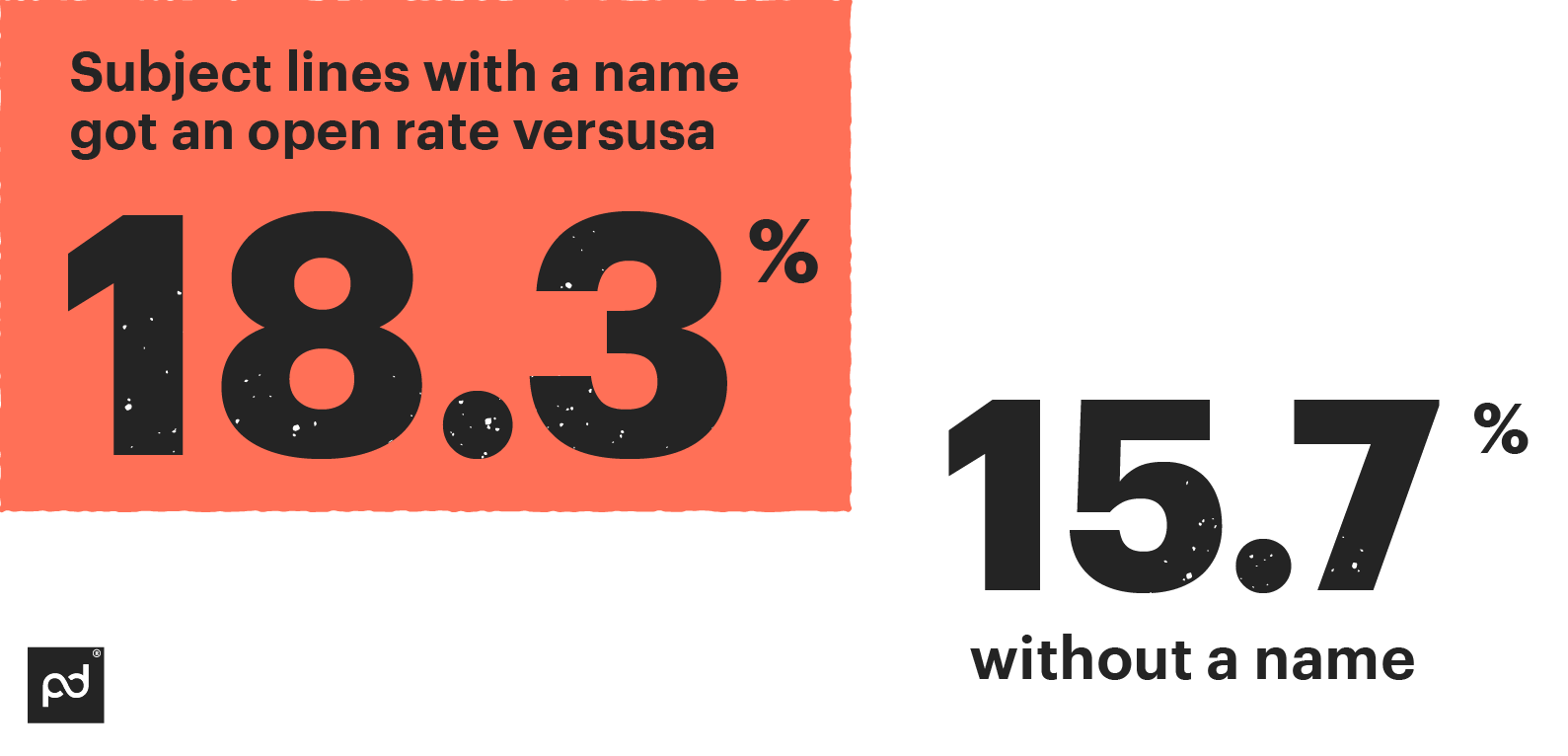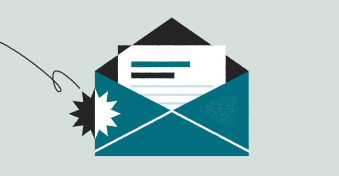When was the last time you opened a sales email? It’s a difficult question to answer, isn’t it?
Heck, many of us skip past the emails from companies and mailing lists we’ve gone out of our way to sign up to! So what chance does a general outreach email have of piquing someone’s interest?
Well, email marketing is actually one of the most effective sales strategies there is. The trick is knowing how to write them so that they’re not immediately confined to the spam folder, never to be seen again.
As of 2023, just less than 35% of emails across all industries get opened, so to stand a chance, yours needs to stand out and catch your prospects’ attention.
In this article, we’ll cover how to master the sales email and share 12 of the best engagement sales email templates that you can simply copy and paste to give your business the best chance of acquiring more customers.
The 8 essential parts of an effective sales email
A good sales email has to be carefully written and structured to attract leads, make them want to open it, keep them interested throughout the entire sales flow, and hopefully convert the leads into loyal customers.
The best sales email templates follow a specific structure. We’ve provided this structure below and explained why they are important.
Keep in mind that an email template is not one-size-fits-all when writing each part. Keep your target prospect in mind and personalize it so that it speaks directly to them.
There are 8 critical boxes that you should make sure your sales emails tick if you want to help nudge prospects in the right direction.
1. Write an intriguing subject line
An interesting subject line that intrigues the prospect is key – after all, this will determine whether they will open your email or ignore it and let it get lost in the pile of cold emails they get every day.
Interestingly, a study shows that 33% of people open emails because of the subject line. Here are some things you should keep in mind when writing it:
Be friendly, not sales-y
In other words, don’t sound like a sales rep. Think about how many times you have ignored a sales email because it sounds like all a company wants is to sell you something that you don’t need.
Furthermore, if your email provider detects that it sounds like a standard sales email template, it may end up in the spam folder.
Here are some tips for making subject lines sound friendly:
- Pretend you are writing to a friend.
- Personalize it to the customer as much as possible. If you can, use their name. According to a study by Zippia, emails that include the recipient’s name in the subject line have a 41% click-through rate and a 29% open rate. Make sure you spell their name correctly!
- Don’t pitch your sales/products or services in the subject line.
- Use laid-back language instead of formal or market-y language.

Some good examples of friendly, personalized subject lines:
- Jerry recommended I get in touch
- Hey, [name], I loved your blog post on [website name]
- Hi, [name], [question]?
- Hey! Our [product/service] has your name all over it
- Steli, your thoughts?
Keep it concise
Most subject lines get cut off if they are over 90 characters, so the key is to keep it short.
The Zippia study shows that, on average, email subject lines between 61-70 characters are read the most, at 17%.
Avoid words that make it sound like spam
Sales emails with product pitches or sales-y words like sales, discount, upgrade, offer, complimentary, and save give off bot vibes and will probably either automatically or manually end up in the spam folder or get deleted without being opened.
Some examples of bad subject lines that sound like spam from Close:
- Steli, webdesign services 20% discounted
- What’s up, [name]? Hit me up if you’re interested in [product/service]
- This is what you need: our [product/service]
- Let’s get down to business. Are you interested in [product/service] or not?
Pay attention to grammar, caps, and punctuation
This goes for the whole email, but a good subject line must appear clean and not spammy, as it’s the first thing your prospects will read.
- Avoid all caps
- Don’t capitalize the first letter of every word
- Try not to use any type of brackets, unless really necessary
- Make sure tags work and don’t show up as tags
- Don’t overuse emoticons, but one is ok
- Don’t overuse question marks or exclamation marks
Make the reader smile
Say something funny, ask a thoughtful question, or use song or movie references. Emotional content is 94% more effective than rational content, according to the Zippia study.
Examples of companies who have done this as seen on Optinmonster:
- UncommonGoods: As You Wish (a reference to the movie The Princess Bride)
- TicTail: Boom shakalak! Let’s get started.
Bring up a pain point in your prospect’s industry
Addressing your prospect’s or customer’s pain point before they open the email will pique their curiosity and will most likely entice them to open the email.
Here are some examples of pain point sales subject lines we found on Ringcentral:
- Are you struggling with (pain point)? You’re not alone.
- Fix your (pain point) in (X) weeks
- (X) workarounds for your (pain point)
To learn more about your prospect and their points, research them. Check out our blog post on writing cold emails that convert for tips on researching.
2. Provide immediate value
Use words like tips, workarounds, best practices, ideas, and secrets – these make it sound like your email will help them in some way.
In the email, actually share tips and provide valuable advice on something in your industry.
- (X) tips for improving productivity in the workplace
- (X) gift ideas for busy mothers
3. Have a strong opening line
After you get the prospect interested enough to open your email, you must keep their attention and ensure that the first sentence is captivating.
Opening lines should have a friendly tone and only be one of two sentences.
A good sales email opening line does one or more of the following:
- It clearly explains what the email is about and why you’re writing to the customer or prospect.
- It introduces you / your company and establishes you as a trusted brand.
- It keeps the reader curious so that they want to read on to the sales offer.
You can make the opening line actionable and make the reader feel compelled to answer:
- Ask if they need help with something in their business or industry.
- Ask a question about something they can help you with.
- You may want to send your initial email to a friend or acquaintance to request that they connect you with the right person, in which case you should mention any mutual connection at the beginning of the email once you have the right person.
You’ll see some examples of each of these in the templates below.
4. Provide value in the email body
After you’ve managed to get your customer or prospect intrigued with the opening line, it’s time to slowly warm them up to your sales pitch.
Your sales email body should align with both your goal and the customer’s or prospective customer’s goal.
- Show that you understand what they need and how you can help them.
- Make sure it’s easy to read. According to a study by Boomerang, emails that are written at a 3rd-grade level “provided a whopping 36% lift over emails written at a college reading.”
- Keep your email body to the point while ensuring that it provides enough detail. In the same study, Boomerang noticed that emails that had between 50 and 125 words yielded response rates of over 50%.

Of course, the content in the email’s body should depend on the goal of your email. We’ll show you some examples in the templates below.
5. Introduce an irresistible offer line, or sales pitch
Write a short paragraph detailing how you can help them:
- Talk about their pain point and what solutions you provide.
- Back it up with research – include testimonials, statistics, case studies, and links that show how effective your solution is.
6. End with a strong closing line
The closing line should have a clear call to action (CTA). The CTA should prompt the prospect to respond or take action, like scheduling a meeting with you so that you can move forward.
The best way to do this is to ask a question that prospects can answer promptly and quickly.
Here are some examples from Hubspot:
- Do you have time on your calendar to discuss this?
- Does it make sense for us to talk? If not, who is the best person for me to talk to?
- Do you have any more questions I can clear up?
- If you aren’t interested, do I have your permission to close your file?
- Would you be interested in X result?
Including a call to action in your emails is sure to help boost conversions.
7. Have a credible email signature line
A professional and credible email signature follows this format:
(Your name)
(Your title)
(Company name)
(Your phone number)
(Any links where they can find out more about you / your company – website, social media links, link to your latest blog, rewards)
Email sales templates: 12 winning types you should know and how to write them
There are thousands of different ways an email can be written, but some types of sales emails have been proven to be more effective than others.
That’s why we’ve collected some of the most powerful email templates for sales from our partners and written five great sales email templates ourselves so you can use them to help your business close more sales.
You know better than anyone that sales reps are busy, which is why saving time with proven email templates and powerful automation tools is worth pursuing to free up valuable time.
If your team needs a sales email template that gets the job done, look no further. Each of these templates can be easily customized for your own purposes.
1. The introduction email
Your sales reps can use this email type to form new connections and make prospects aware of you and your company.
An introduction email is short and sweet and doesn’t pressure the prospect to buy anything from you but lets them know that you are there to help if they are interested.
Introduction emails or sales prospecting email templates are especially effective at establishing a connection between you and the prospect while making them more aware of the product or service that your business offers and how it can help them.
Hi (name),
I’m (name) and I’m the (title) at (company). (Company) was founded in (year) and since then, we have grown now serve over (number of) customers every year. At (company), we pride on providing (products or services) that help with (list their benefits).
I’m writing because I came across your (website /LinkedIn profile) / because we have a mutual friend, (friend name). It seems like you / your audience would benefit from learning more about (subject, industry, product, or service). I’ve been working in the industry for (number of) years and would be happy to provide you with any information.
Let me know if you would like to hear more. You can also find more details on our website and social media profiles.
Have a great day,
(Your name)
(Your title)
(Company name)
(Your phone number)
(Relevant company or social media links)
Want more business document templates to power your sales team? Check out our library of 750+ free business templates!
2. Cold email outreach
Cold email outreach can be somewhat similar to introduction emails but with more of a direct self-promotional component to whet your prospect’s appetite to get more information about your organization.
As reported by Salesmate, the average conversion rate of cold emails in 2020 was 15.11%, but 75% of surveyed executives are willing to make an appointment or attend an event based on a cold call or email alone.
That’s a huge discrepancy, and it shows the opportunity available for your business to capitalize on simply by using an effective cold outreach email template like this one from Salesmate.
The great thing about cold sales email templates is that they can often be used en masse with minor variations per prospect, meaning they require minimal effort yet can generate significant results.
3. Request a meeting
Most initial outreach methods are just ways to get your foot in the door and set up a meeting.
Without an appointment, you’re unlikely to get enough time to talk to your prospects and convince them of the value of your products or services.
That’s why this type of sales email can be so useful. The purpose of the request for a meeting email like this template from Hubspot is entirely to get an appointment on the books with your prospect.
These types of emails are low-pressure ways to convince prospects to set up an appointment and can be a useful tool to get more prospects into your marketing funnel.
4. Free trial
Free trials are an excellent way for prospects to experience your product or service firsthand before deciding to commit.
Ideally, they’ll have a fantastic experience and convert to a paying customer.
However, a survey of over 300 SaaS professionals showed that, on average, only 20% of free trial users upgrade to a paid plan.
That means there’s massive room for improvement in turning free trial users into paying customers; this email is one way you can do that.
Free trial emails can deliver huge benefits like preventing warm leads from turning cold and even turning free trial users into paying customers who contribute to your bottom line.
Hi (name),
You’re (number) of days into using (your company’s solution), and it looks like you’re already starting to get results! (share relevant data about the prospect’s positive experience so far if possible)
This is a great time to consider taking a look at our different plans so you can take full advantage of (product) because of (special promotion, availability, etc.).
On average, our customers see (data-driven benefit). Plus, if you upgrade your account, you’ll get:
- [Feature] that enables you to [benefit].
- [Feature] that helps you with [benefit].
- [Feature] that allows you to [benefit].
If you’re ready, take a look at our premium plans here (link to your sales page).
If you need help making the right choice for your business or have any questions, don’t hesitate to reach out anytime – I’d be happy to help!
Best,
(Your name)
(Your title)
(Company name)
(Your phone number)
(Relevant company or social media links)
Professional templates can save your business valuable time while optimizing critical processes, and the PandaDoc library is loaded with over 750 business templates you can access for free today.
5. Scheduling product demo
Product demos are an excellent way to familiarize your prospects with your company’s products or services while building rapport. The challenge is getting a prospect to agree to a product demo.
That’s where this short and sweet email template from ZenDesk comes in! It’s geared toward a prospect with whom you already have a relationship, but you can tweak it based on the level of your relationship.
Using a demo scheduling email like this can help your prospects go from cold to warm while naturally pointing the conversation towards a sale.
6. Sales pitch
A sales pitch email is a one-on-one email that’s meant for one of your individual prospects based on their business and needs.
In this type of sales email, you need to draft a compelling email body to evoke your prospect’s interest. Especially considering that according to Statista, 333.2 billion e-mails were sent and received daily in 2022.
Sales pitch email templates like this one from Salesmate are the most direct method to improve conversation rates because they allow you to maximize your engagement with high-end prospects.
Use this type of email to spread some brand awareness while simultaneously showing your prospects how you can solve their specific pain points.
7. Follow-up
Follow-ups are a key practice of successful sales teams, especially since Invesp reports that 60% of customers say no four times before saying yes.
Meanwhile, they also revealed that 48% of salespeople never even make a single follow-up attempt.
You can potentially have a significant impact on your overall conversions just by sending simple follow-ups to your prospects, and you can use this top-tier sales email template from HubSpot to get the job done.
Your sales team can use follow-up emails to keep the conversation going with your prospects and to prompt an action-oriented response.
You can even stuff in some additional value that might help close the sale.
8. Social outreach
According to Forbes,

That’s exactly why social outreach and having strong templates like this one from HubSpot to work with for platforms like LinkedIn or even Facebook and Instagram is so critical for your business.
Utilizing social outreach emails will help you get into your prospect’s mind in a different way, forming a connection with less pressure than they might feel through other mediums.
9. After events
Many businesses host seminars, webinars, or conferences meant to provide value and help convert prospects.
Rather than letting the conversation end after the event, why not send an after-event email to further the relationship between your organization and the prospect?
This email is perfect for following up with a prospect after an event, sharing more value, and hopefully, moving the relationship to the next step.
Hi (name),
I wanted to say a big thank you for attending (event name) on (date). I hope we made it well worth your time! As promised, we’re sending a recording of the event as well as the slides and some additional resources you may find helpful:
(link to the recording, slides, and additional resources)
Please feel free to share these with any of your colleagues who may be interested.
Did you have any questions or feedback? I’d love to set up some time with you to discuss it further. How does (day and time) work for you?
Thanks again!
(Your name)
(Your title)
(Company name)
(Your phone number)
(Relevant company or social media links)
High-quality sales templates can help sales reps maximize their time and close more deals, which is why many sales teams use PandaDoc’s free templates.
10. Competition comparison
A competition comparison email is an opportunity to show your prospects how your business is superior to your competitors. The best way to do that is to use unbiased data or third-party reviews.
This type of email is ideal once the initial contact has already been made. It allows you to bridge the initial contact to a meeting by giving your prospect something to think about in the meantime.
Hi (name),
Thanks for (completing action i.e. submitted an email, set up a phone call, met in person, etc.)! I’m excited to continue the conversation during our upcoming (meeting or call).
In the meantime, I wanted to share this side-by-side comparison of us and some of our top competitors with you.
(link to the comparison chart, positive third-party review, or social proof)
As you can see, we really pride ourselves on (name biggest competitive advantages), and that’s important to our customers.
Let me know if you have any questions. Otherwise, I’m looking forward to talking soon!
Best,
(Your name)
(Your title)
(Company name)
(Your phone number)
(Relevant company or social media links)
11. Reminder
You’re probably well aware that most people are flooded with emails every day, so it’s common for emails to get lost in the weeds.
It’s also easy for prospects to lose track of a scheduled meeting or product demo, which is why a simple reminder email can be a helpful solution.
It’s a simple tool to help your prospects remember important events, and it can significantly boost the rate of prospects showing up for scheduled meetings.
This Salesmate email template is specifically a meeting reminder, but it can also be easily tweaked to serve other reminder purposes.
12. Thank you emails
Saying thank you isn’t just good manners. It’s also a big piece of an effective sales process. It shows that you appreciate your prospect’s time and potential business.
Not only does a good thank you email like this template from Salesmate help build stronger relationships between you and your prospects or customers, but it also can be an opportunity to advance the conversation in the direction you want while remaining professional.
Create the best email templates for sales with PandaDoc
Now that you’ve learned the ins and outs of email outreach, you’re well on your way to optimizing your sales efforts and closing more deals with new clients using sales email templates that work.
But effective sales email templates are just the start.
There are all sorts of other ways that PandaDoc can help you meet your sales goals.
Many sales teams have experienced significant efficiency improvements simply by using PandaDoc’s automation software.
Our product is specifically built for fast-paced sales teams looking to impress prospects and shorten the sales cycle.
If that sounds like something that could benefit your team, check it out for yourself without any obligations using our 14-day free trial.
Disclaimer
Parties other than PandDoc is not a law firm, or a substitute for an attorney or law firm. This page is not intended to and does not provide legal advice. Should you have legal questions on the validity of e-signatures or digital signatures and the enforceability thereof, please consult with an attorney or law firm. Use of PandaDocs services are governed by our Terms of Use and Privacy Policy.
Originally published December 17, 2018, updated February 1, 2024


